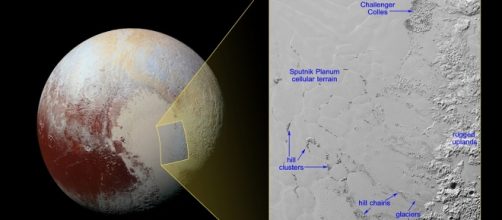When Pluto was first discovered in 1930 by Clyde Tombaugh it was a tiny dot that could be seen only by a telescope. All of that changed in July 2015 when NASA’s New Horizons space probe flew by the dwarf planet in a signature feat of space exploration and took images and garnered data that has transformed it into a totally alien and fascinating world.
Pluto features plains of nitrogen ice and hills of water ice that are harder than rock. It has a hydrological cycle, of a kind, in which the nitrogen evaporates in the air and then falls as sleet and snow onto Pluto’s surface.
The dwarf planet is enveloped in a haze of nitrogen gas that ranges in layers from near the surface to 60 miles high,
The most recent finding from New Horizons show that ice bergs have broken off from the hills surrounding the Sputnik Planum, a glacier of nitrogen ice, and are floating slowly across its surface, eventually to cluster together in places like the Challenger Colles, informally named after the crew of the space shuttle Challenger, which was lost just over 30 years ago. The feature is an especially high concentration of icebergs, measuring 37 by 22 miles. The icebergs float on the nitrogen ice plain because water ice is less dense than nitrogen ice.
New Horizons was launched in 2006 and spent nine and a half years on its voyage to Pluto.
The NASA space probe is currently voyaging deeper into the Kuiper Belt, an area cluttered with objects made of ice and rock that are thought to be debris left over from the birth of the solar system. The probe is due to encounter one of these objects sometime in 2019. In the meantime New Horizons continues to transmit data and images that it acquired during its brief flyby of Pluto.
Ironically, when New Horizons rocketed from Earth, Pluto was still considered a planet. But, in a controversial move, a group of astronomers designated it as a “dwarf planet.” The matter is still disputed in some corners of the scientific community, with some voices raised to restore Pluto’s status as a full-fledged planet.

